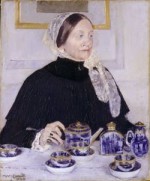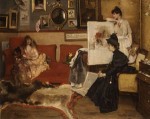Column Name
Title
In 1985 a group called the Guerrilla Girls captivated the media. Wearing gorilla masks and taking the names of dead female artists, they publicized and protested the underrepresentation of women in exhibitions at the Museum of Modern Art, the Guggenheim, and major private New York City art galleries. With this in mind, and with March designated as Women’s History Month, I set out recently for the Metropolitan Museum of Art, New York City’s number one tourist attraction, to see if the situation has changed. My conclusion surprised even me. Although the percentage of women artists represented is still disappointing, numbers do not tell the whole story. The fact is that progress has been made. The awe-inspiring power of the women artists the museum currently features is underlined by the new placement of their art works.
Body
Years ago, the European Painting Galleries on the second floor included almost no women artists. The one or two they possessed were hidden away in corners. Today, one of the first paintings to meet your eye (in Room 2) is Adélaïde Labille-Guiard’ s 1785 Self-Portrait with Two Pupils. Prominently positioned on the front wall, a few paintings away from David’s Death of Socrates, the canvas shows the stunning artist looking straight out at us as she works, palette and paintbrush in hand. She is fashionably dressed, in a low-cut gown and fancy hat; two worshipful young female disciples look over her shoulder. A virtuosic artist, Labille-Guiard was also an early feminist. One of only four women members of the French Royal Academy, she advanced the cause of other female artists by arguing effectively for the dropping of quotas for women academicians. In addition, she proposed state-subsidized art education for women. Though this did not succeed, she continued to paint and had a career as a dedicated teacher, training many successful women students.
On an adjoining wall, Élisabeth Vigée-LeBrun is represented by two canvases, one a portrait of Madame Grand (Catherine Noële Worlée, 1762–1835), Later Madame Talleyrand-Périgord, Princesse de Bénévent (1783), the other, a portrait of a man, Alexandre Charles Emmanuel de Crussol-Florensac (1783). Both are dramatic, skillfully painted, very flattering portraits. Vigée-LeBrun, another of the four women academicians, is best known as portraitist to the queen, Marie Antoinette. She lived a long life (1755-1842), was forced into exile for about a dozen years after the French Revolution, but returned to France after Napoleon took power. Unlike most women professionals of her day, she was inordinately successful wherever she went. She married, had a daughter, and nonetheless turned out 660 portraits and more than 200 landscapes. Because of the publication of her extensive memoirs, we know more about her than about any other woman artist during her lifetime.
The subject of Marie-Victoire Lemoine’s Atelier of a Woman Painter (1796), in the same gallery, has been identified as the studio of Vigée-LeBrun. If this is the case, then it shows Vigée-LeBrun teaching a young woman (perhaps the artist herself) to paint. At any rate, it is the homage of one woman painter to another.
Another painting that pays tribute to a woman artist in a less overt way is, in fact, the work of a man. Jacques Louis David’s well known portrait of Antoine-Laurent Lavoisier and His Wife (Marie-Anne-Pierrette Paulze) (1788) holds a revelation. Lavoisier’s wife is painted more prominently than the famous scientist himself. Appearing as a sort of muse, we now know that Paulze was David’s painting student. She illustrated her husband’s published writings, and a portfolio of her drawings rests on an armchair in the background.
After looking at these late 18th-century women, I went to the newly renovated 19th-century galleries. There I found four women artists: Louise Joséphine Sarazin de Belmont (1790-1870); Rosa Bonheur (1822-99); Mary Cassatt (1844-1926); and Berthe Morisot (1841-95).
I had never heard of the first artist listed here, but she was the only one I came across in room after room of early 19th-century paintings. Her small oil/paper study The Roman Theater, Taormina, Sicily (1825) shows ancient ruins with Mount Etna erupting in the background. A bit of research informed me that she painted many romantic landscapes, including some of the forest of Fontainebleau, and painted a tribute to the Baron Gros in the Père Lachaise Cemetery in Paris. She is often listed as the only woman painter exhibiting among numbers of men.
Rosa Bonheur, on the other hand, was well known to me; I have admired her huge The Horse Fair(1853) since I can remember. It was always hung in the large hallway, and I momentarily panicked when I couldn’t find it. Now its placement is actually better: in a large room filled with Courbets, where it really belongs, and takes pride of place. Bonheur, who never married, and who had to obtain permission from the Prefecture of Police in 1850 to wear trousers (the document, still preserved, calls it “cross dressing”) was extremely famous in her day as an animalier (painter of animals). The power, size, energy, and virility of her painting overshadow even the infamous Les Demoiselles de Village (1851) of Courbet.
Mary Cassatt, the best known of all, was an American who spent most of her life in Paris. HerLady at the Tea Table (1883-85) is far less sweet and “feminine” than any of the Renoirs in the same gallery. The same is true of her painting of her sister, Lydia Crocheting in the Garden at Marly (1880). Morisot, who influenced her brother-in-law, Edouard Manet, to become an Impressionist, is represented by a Young Woman Seated on a Sofa (1879), as well as an early The Pink Dress (1870) in a gallery surrounded by Fantin-Latour still lifes, Renoirs, and Monets.
At the end of the main hallway hangs a perplexing painting, another portrayal of a woman artist by a man. This time, the painter is Alfred Stevens; the painting, In the Studio, 1888. The label maintains it is Stevens’ studio, but his subjects are a woman artist and her model taking a break from a painting session. One wonders why they are in his studio and why he painted them.
As I examined the Met’s painting galleries, I saw that the museum has certainly taken steps forward in recognizing women artists from the centuries leading up to the 20th century. Of course, the exponential increase of women artists during the 20th century means they will be represented in far greater numbers in the 20th-century galleries—but that topic is suitable for another article! While advances have been made there, still more progress is called for.
The Met, located on Fifth Avenue at 82nd Street, is open Sunday and Tuesday-Thursday from 9:30 a.m.-5:30 p.m., and Friday and Saturday from 9:30 a.m.-9 p.m. It is closed Mondays, except for major holidays.
Images, from top: Rosa Bonheur: The Horse Fair, 1853–55, oil on canvas; Mary Cassatt: Lady at the Tea Table, 1883–85, oil on canvas; Alfred Stevens: In the Studio, 1888, oil on canvas. Images © The Metropolitan Museum of Art, New York.







